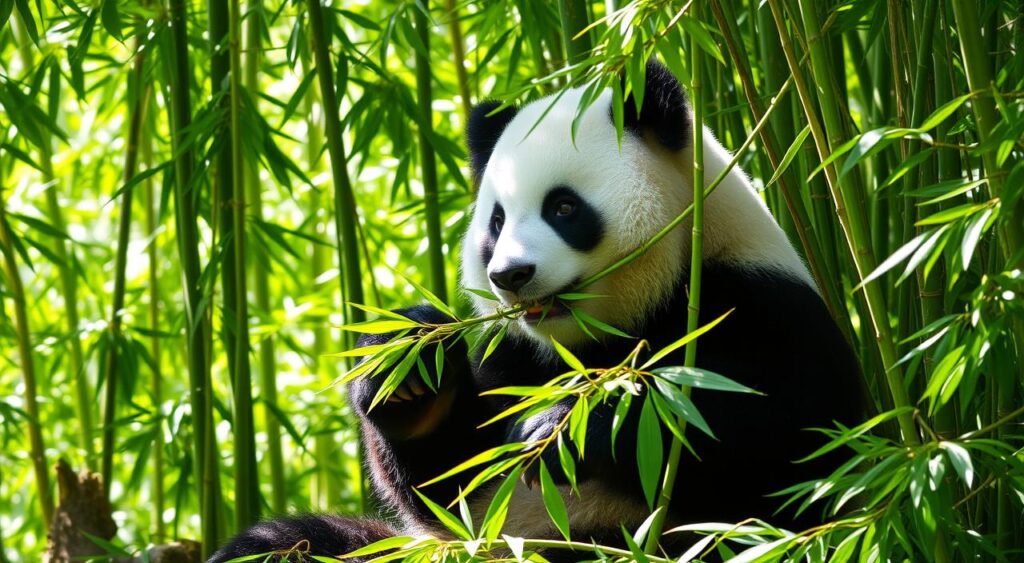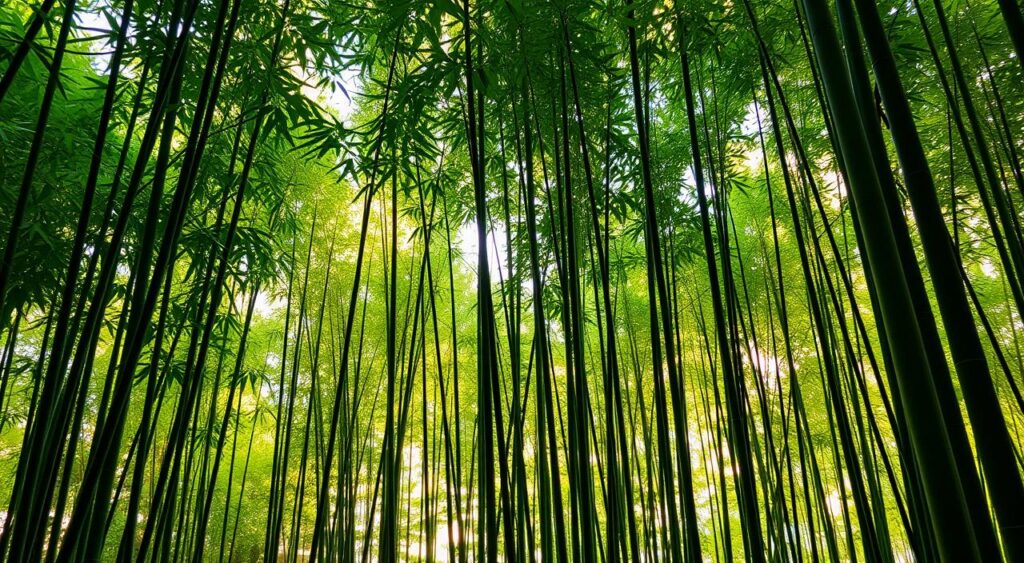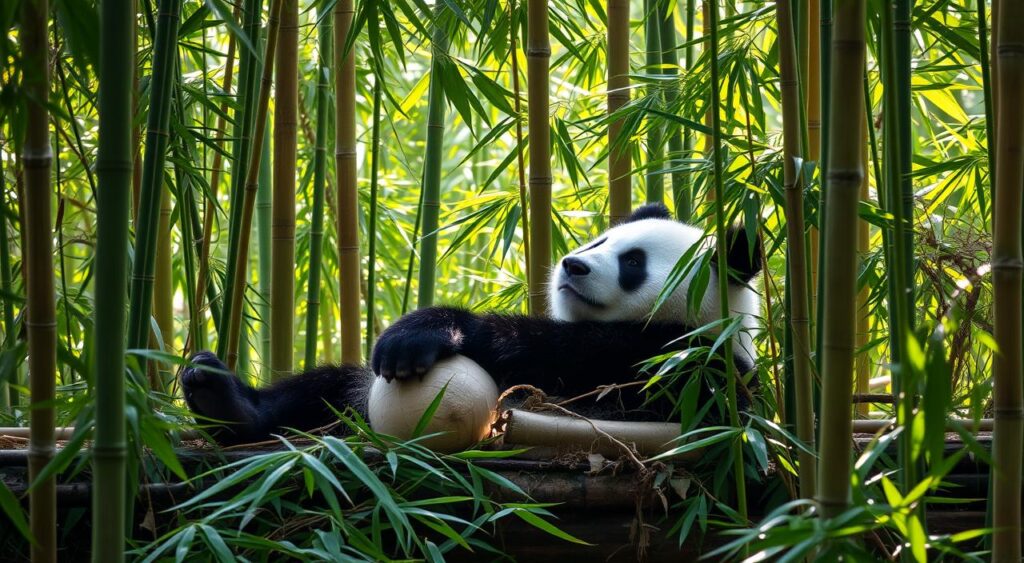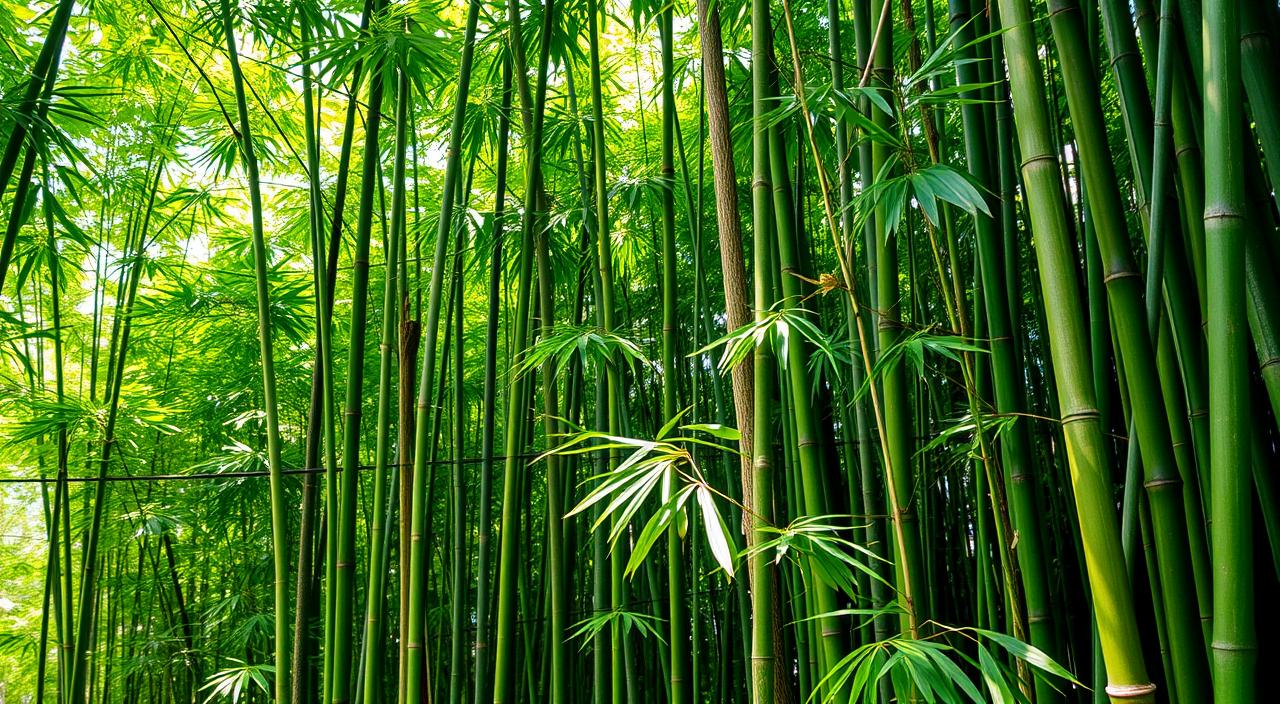Bamboo and the giant panda bear are symbols of the Orient. Pandas mostly eat bamboo, with 30-40 species making up 99% of their diet. They live in elevations of 1,500-3,000 meters, where they find Fargesia bamboo species like F. robusta and F. dracocephala.
Other bamboo species pandas like include Phyllostachys glauca and Yushania brevipaniculata. In zoos, pandas have access to more bamboo types. They prefer Square bamboo, Thorny bamboo, and Bissetii.
Key Takeaways
- Pandas in the wild primarily consume bamboo species from the Fargesia genus, such as F. robusta, F. dracocephala, F. rufa, and F. nitida.
- Other popular bamboo species for pandas include Phyllostachys glauca, P. bissetii, Yushania brevipaniculata, and Bashania fargesii.
- In captivity, pandas exhibit preferences for Square bamboo, Thorny bamboo, Bissetii, and Water bamboo.
- Bamboo makes up around 99% of a panda’s diet, with the bears consuming approximately 30-40 different bamboo species.
- Pandas typically inhabit elevations between 1,500-3,000 meters, where their preferred bamboo species are most abundant.
What Is the Diet of the Giant Panda?
The giant panda is famous for eating almost all bamboo. In fact, over 99% of their diet is bamboo. They eat about 23–40 kg (50–90 lb) of bamboo daily to get enough energy.
The Giant Panda’s Dietary Preferences
In the wild, giant pandas eat around 30 to 40 bamboo species. The most common are Fargesia species like F. robusta and F. dracocephala. In zoos, they enjoy eating Square bamboo and Thorny bamboo.
Pandas love to eat every part of bamboo, from shoots to older stems. Even though they are bears and carnivores, they mostly eat bamboo. The rest of their diet includes some plants, small rodents, and sometimes meat.
The Evolution of the Giant Panda’s Diet
Studies show that giant pandas used to eat more meat. But, over 7 million years, they changed to mostly eat bamboo. By 2 million years ago, they were fully adapted to eating bamboo, with special features in their skull and paws.
Pandas spend over 10 hours a day eating bamboo. This is because their digestive system isn’t great at breaking down plants. So, they need to eat a lot to get enough energy.
Bamboo species for pandas

Giant pandas mainly eat bamboo. They live in high places, from 1,500 to 3,000 meters. There, they find different Fargesia bamboo species.
Some favorite bamboo types for pandas are Fargesia robusta, Fargesia dracocephala, Fargesia rufa, and Fargesia nitida. In zoos, pandas also enjoy eating Phyllostachys glauca, Phyllostachys bissetii, Yushania brevipaniculata, and Bashania fargesii.
In zoos, pandas like Square bamboo, Thorny bamboo, Bissetii, Square bamboo, and Water bamboo. They love the fresh shoots of bamboo. These shoots have a lot of protein, up to 32%.
| Bamboo Species | Panda Preference | Habitat | Nutritional Value |
|---|---|---|---|
| Fargesia robusta | High | 1,500-3,000 meters | Fresh shoots: 32% protein, Leaves: 19% protein |
| Fargesia dracocephala | High | 1,500-3,000 meters | Fresh shoots: 32% protein, Leaves: 19% protein |
| Phyllostachys glauca | High | 1,500-3,000 meters | Fresh shoots: 32% protein, Leaves: 19% protein |
| Square bamboo | High (in captivity) | N/A | Fresh shoots: 32% protein, Leaves: 19% protein |
Having many bamboo species is key for pandas. It helps them survive and thrive. We must protect these bamboo areas to save the pandas.
The Importance of Bamboo Diversity for Giant Pandas
Giant pandas are beloved icons of conservation. They face a unique challenge in their diet. These bears almost exclusively eat bamboo, consuming up to 40-80 pounds daily. Their diet makes them vulnerable to changes in bamboo species availability.
Pandas live in Sichuan, Shaanxi, and Gansu provinces of China. They thrive in dense bamboo forests. But, when certain bamboo species flower and die, pandas face food shortages. This can lead to starvation and population decline.
Conservation efforts aim to maintain bamboo species diversity. This ensures pandas have a consistent food supply. It’s vital as environmental changes like deforestation and urbanization threaten their habitat.
Pandas prefer certain bamboo species and parts, like culms, leaves, and shoots. Understanding these preferences helps conservationists protect key bamboo species. This ensures a stable food source for endangered pandas.
The importance of bamboo diversity for giant pandas is huge. By preserving bamboo species diversity, we can protect these remarkable animals. This ensures their long-term survival.
The Impact of Bamboo Harvesting on Giant Pandas

Many worry about how bamboo harvesting affects giant pandas. But studies show the main danger is habitat loss, not bamboo farming. This loss happens because of human activities.
Giant pandas mainly eat bamboo. They prefer certain types, like those from the Fargesia genus. These bamboos grow in central China’s mountains, far from where Moso bamboo is farmed.
The Cultivation of Moso Bamboo
Moso bamboo is widely grown in China for products like flooring and textiles. Giant pandas don’t eat Moso bamboo because it’s not as nutritious as their natural food. So, growing Moso bamboo doesn’t harm pandas.
A study in the Wolong Nature Reserve showed local people mostly eat bamboo shoots. Only a little is sold. This means bamboo harvesting doesn’t hurt pandas much, as long as it’s done carefully.
Efforts to save giant pandas include creating nature reserves in China. Now, there are 67 reserves protecting them. The panda population is about 1,864, spread across 33 areas, according to recent counts.
“The conservation of the giant panda is a global priority, and understanding the impact of human activities on their habitat is crucial. Fortunately, the evidence suggests that the cultivation of commercial bamboo species does not pose a significant threat to the panda’s survival.”
Bamboo Intake Factors for Captive Giant Pandas

Keeping captive giant pandas healthy is key. Studies reveal many factors affect their bamboo eating habits. These include seasonal changes, bamboo age, and where the bamboo grows.
In spring and summer, captive pandas eat many bamboo types. But, in winter, they have fewer choices. They love bamboo leaves that are 1 year old and bamboo culms that are 5 years old.
The direction a bamboo slope faces matters too. Pandas prefer bamboo that grows in sunny or semi-sunny spots. This shows how environment affects their eating habits.
When and how bamboo is cut also matters. Pandas eat more when bamboo is cut and fed to them within 24 hours. This keeps the bamboo fresh and moist.
“Understanding the factors that influence bamboo intake is essential for providing captive giant pandas with a nutritious and satisfying diet, which is crucial for their overall health and well-being.”
Zoos and research centers can use this knowledge to better feed captive pandas. This ensures they get the nutrients they need to stay healthy.
Research on captive giant pandas has given us important insights. It helps us improve their diet and care. This is good for their health and for saving the giant panda species.
Also Read : What Pandas Eat: 5 Fascinating Facts About the Panda Diet
Conclusion
The giant panda’s love for bamboo is amazing. They eat 30-40 different bamboo species, making up 99% of their diet. In the wild, they mostly eat Fargesia genus bamboo like F. robusta and F. dracocephala. In zoos, they get to try more types, including Square bamboo and Thorny bamboo.
But, their diet makes them vulnerable. Bamboo’s growth patterns, like mass flowering every 20 to 40 years, are a big challenge. Even though bamboo farming for other uses doesn’t hurt them, knowing what affects their bamboo eating is key. This knowledge helps care for pandas in zoos and protects them in the wild.
Bamboo is essential for pandas to survive. Keeping a variety of bamboo species available is crucial. This ensures pandas get the best bamboo, helping them stay healthy and supporting their conservation.
FAQs
Q: What type of bamboo do pandas eat?
A: Pandas primarily consume bamboo, which is the main food of their diet. They need to have at least two different species of bamboo available to meet their nutritional requirements.
Q: How much bamboo do wild pandas eat daily?
A: Wild pandas can eat as much as 84 pounds of bamboo each day to meet their energy needs, as bamboo is low in calories and they need to consume large quantities.
Q: Are there different species of bamboo that pandas prefer?
A: Yes, pandas prefer certain species of bamboo. In the wild, they typically rely on around 25 bamboo species, but they must have at least two different species available at any given time.
Q: Do red pandas eat bamboo like giant pandas?
A: Yes, red pandas also eat bamboo, but their diet is more varied. While bamboo is a significant part of their diet, they may also consume fruits and insects, unlike giant pandas which primarily eat bamboo.
Q: How much time do pandas spend eating bamboo?
A: Pandas spend at least 12 hours a day eating bamboo to fulfill their nutritional requirements due to the low energy content of the bamboo plant.
Q: What are some facts about pandas and their bamboo diet?
A: Pandas’ main diet consists of bamboo, which they rely on heavily. They have adapted to this diet, and despite being classified as carnivores, they eat meat only occasionally. Their digestive system is designed to process bamboo efficiently.
Q: Why is bamboo important for pandas in the wild?
A: Bamboo is crucial for wild pandas as it constitutes about 99% of their diet. Different species of bamboo provide the necessary nutrients, and the availability of bamboo influences panda populations in the wild.
Q: How does the life cycle of bamboo affect panda populations?
A: The life cycle of bamboo can affect panda populations significantly. Bamboo species can experience mass die-offs every few decades, which can lead to food shortages for pandas, making it critical for them to have access to various bamboo species.
Q: What challenges do pandas face regarding bamboo availability?
A: Pandas face several challenges, such as habitat loss and climate change, which threaten the availability of bamboo species in the wild. Conservation efforts focus on protecting habitats where these bamboo species thrive.
Q: How do zoos manage the bamboo diet of pandas?
A: Zoos ensure that giant pandas in captivity have a balanced diet by providing them with a variety of bamboo species. They monitor their health and nutritional needs closely to replicate their natural diet as much as possible.

